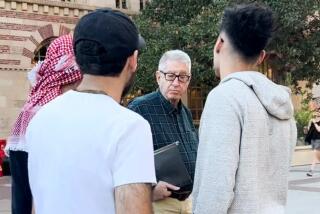Column: Firing an art history professor for showing students an image of the prophet Muhammad is out of line

The art history instructor was diligent, empathetic and sensitive. She gave plenty of warning, including in her class syllabus, letting her students know ahead of time that she planned to show them ancient depictions of the prophet Muhammad as part of her global art history course at Hamline University, a private liberal arts college in Minnesota.
The teacher, Erika López Prater, 42, did this because she was aware that many Muslims believe showing the face of the prophet is a kind of blasphemy, and that some of her Muslim students might take offense at the images she planned to show. In any case, their participation in the lesson was optional. As it happens, the images she planned to show are hundreds of years old and considered a masterpieces of Islamic art.
The class took place online on Oct. 6, and again, any student who did not wish to view the images did not have to. According to Hamline’s student newspaper, the Oracle, which obtained a recording of the class, the professor gave a content warning, described the images — in one from the 16th century, Muhammad’s face is veiled; in the other, from the 14th century, it is not — and spoke about their “controversial nature” for more than two minutes before displaying them.
“There is,” López Prater told her students, “this common thinking that Islam completely forbids, outright, any figurative depictions or any depictions of holy personages. While many Islamic cultures do strongly frown on this practice, I would like to remind you there is no one, monothetic Islamic culture.”
One of her Muslim students took offense anyway.
“I’m like, ‘This can’t be real,’ ” senior Aram Wedatalla told the Oracle. “As a Muslim, and a Black person, I don’t feel like I belong, and I don’t think I’ll ever belong in a community where they don’t value me as a member, and they don’t show the same respect that I show them.”
Wedatalla, president of the college’s Muslim Students Assn., complained to administrators. Two days after the class, López Prater apologized to Wedatalla, who made the email available to the Oracle: “I would like to apologize that the image I showed in class ... made you uncomfortable and caused you emotional agitation. It is never my intention to upset or disrespect students in my classroom…. I am sorry that despite my attempt to prevent a negative reaction, you still viewed and were troubled by this image.”
And really, that should have been the end of it.
Nepotism only gets your foot in the door, the nepo babies say. But in Hollywood, getting in the door is the crucial step to success.
Administrators soon announced they would not invite López Prater back for the following semester, essentially firing her — she was an adjunct professor with no tenure protections. David Everett, Hamline’s associate vice president of inclusive excellence, wrote that her lesson was “undeniably inconsiderate, disrespectful and Islamophobic.”
Another email from the administration said that “respect for observant Muslim students in that classroom should have superseded academic freedom.”
In early December, the school also organized a forum about Islamophobia, where a local advocate for Muslim civil rights defended the university’s action, according to the New York Times. “If this institution wants to value those students,” Jaylani Hussein, executive director of the Minnesota chapter of the Council on American-Islamic Relations, said, “it cannot have incidents like this happen. If somebody wants to teach some controversial stuff about Islam, go teach it at the local library.”
In the wider academic world, the university’s handling of the complaint ignited a firestorm that spread to the mainstream media.
PEN America, which supports free expression, accused Hamline of “academic malpractice” and called its treatment of López Prater, who did not respond to my request for comment, “one of the most egregious violations of academic freedom in recent memory.”
AIs can spit out work in the style of any artist they were trained on — eliminating the need for anyone to hire that artist again.
In a statement released Monday, the Muslim Public Affairs Council declared flatly of the 14th century image, “The painting was not Islamophobic.”
It went on to point out that López Prater was emphasizing “a key principle of religious literacy: religions are not monolithic in nature, but rather, internally diverse. This principle should be appreciated in order to combat Islamophobia, which is often premised on flattening out Islam.”
In the Chronicle of Higher Education, Carleton College associate history professor Amna Khalid, who is Muslim, wrote that “barring a professor of art history from showing this painting, lest it harm observant Muslims in class, is just as absurd as asking a biology professor not to teach evolution because it may offend evangelical Protestants in the course.”
A leading scholar of Islamic art also took issue with Hamline’s position on showing the work, which depicts Muhammad receiving his first Quranic revelation through the angel Gabriel.
“Hamline administrators have labeled this corpus of Islamic depictions of Muhammad, along with their teaching, as hateful, intolerant and Islamophobic,” wrote University of Michigan art history professor Christiane Gruber in New Lines Magazine. “And yet the visual evidence proves contrary: The images were made, almost without exception, by Muslim artists for Muslim patrons in respect for, and in exaltation of, Muhammad and the Quran. They are, by definition, Islamophilic… . How did Hamline arrive at such a flawed conclusion?”
Banned Books Critical Race Theory Censorship
Good question.
My guess: Because we live in a world where marginalized groups are tired of being treated as outsiders, tired of being discriminated against. Apologies aren’t enough, and blood must be drawn. Nowadays, especially on college campuses, feelings rule supreme and words sometimes lose their meaning. This is how a professor who is respectfully teaching the importance and value of Islamic art is fired, then tarnished as Islamophobic.
Listen, we all can imagine scenarios where religious belief and academic practice collide, and where religious belief may be presumed to be the more important value — for example, giving a pass to a biology student who refuses for religious reasons to dissect a fetal pig or pith a frog. After all, such a student is not trying to prevent other students from doing the work.
The idea that no one should be able to study historically important images of Muhammad on a college campus because some Muslim students object to them on religious grounds is intellectually indefensible.
I hope that Hamline University officials, instead of digging in, recognize their mistake and reinstate López Prater.
And that the students who were offended will come to understand that they can live out their convictions without trampling on the rights of others.
More to Read
A cure for the common opinion
Get thought-provoking perspectives with our weekly newsletter.
You may occasionally receive promotional content from the Los Angeles Times.















